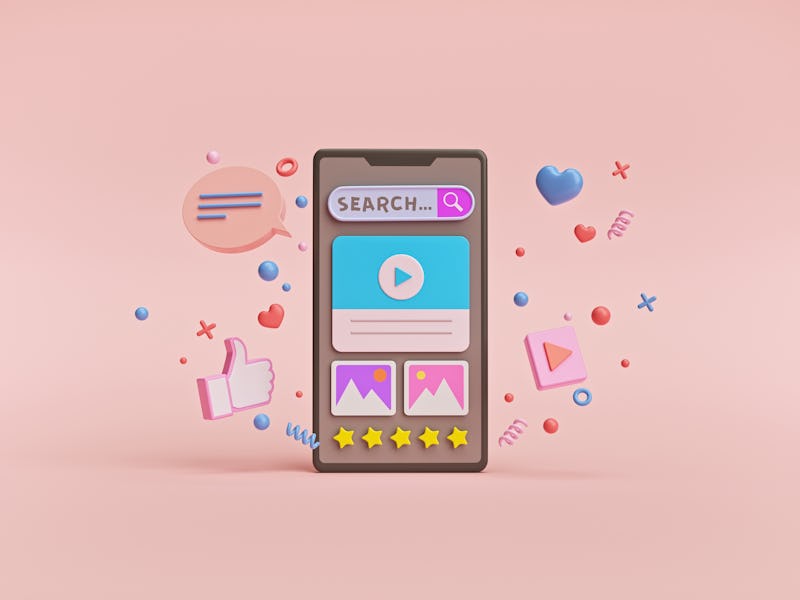There are two ways of using social media — and one is actually good for you
This form of usage "elicits positive feedback from others, social interactions, and even social support."

In the past 24 hours, you’ve probably felt bad about spending time on your phone. Maybe it’s a kick in the gut that you’re on Twitter instead of reading a book; perhaps it’s your partner pointing out you’re still scrolling on TikTok. Despite being something so ubiquitous, so permeated through daily life, time spent looking at a screen is often framed as a guilty pleasure — an act you probably shouldn’t be doing but want to anyway.
The question is: Why do you feel bad about it? Should you even feel bad?
The answer, like most topics of this nature, is complicated — but fascinating to tease out. In a recent study published in the journal Trends in Cognitive Sciences, its authors note there was an explosion of research examining the links between social media use and well-being in the mid-2000s, most of these papers focusing on Facebook. Much of this early research resulted in inconclusive findings. More recently, some “third-generation” studies have found that social media can, in fact, negatively impact the people who used it. After they are published, hand-wringing often ensues.
But incremental papers can mask the complexities underlying the situation as a whole, argue the authors of the new study. Why people use social media, who uses social media, and how people use social media affect the outcome. Social media can enhance or diminish well-being because it’s simply a vehicle for human use or manipulation, not a force with its own intentions.
The “jingle-jangle problem” — Why it can be so difficult to talk about and come to any conclusion, is because of something called the “jingle-jangle problem.” Cory Costello is a postdoctoral fellow at the Emotion and Self-Control Lab at the University of Michigan, and a co-author of the Trends in Cognitive Sciences paper. This fallacy, he tells me, is the assumption that two things are the same because people use a common name to refer to both.
“The basic problem — in the context of social media research — is that people will sometimes use a term like ‘social media usage’ for a variety of experiences, from actively engaging with a close friend on Facebook to looking through an engaging thread on Twitter, to looking at glamor shots of someone on Instagram,” Costello explains.
“Likewise, people sometimes use different terms — online social networks, social media, etcetera — to refer to the same phenomena. Our contention in the paper is that both are an impediment to progress and accumulation of knowledge in this space.”
An illustrative example is examining the link between social media and depression. A recent study published in BMC Medicine found “screen time” was significantly associated with a higher frequency of depressed mood. Here, screen time was described as hours spent in the day looking at the television or a computer. Meanwhile, other research posits that social media can help people with depression because these individuals can sometimes find more support with their counterparts online than the people in their physical circle.
Both could be framed as “screen time use does this,” but it wouldn’t be an accurate way of looking at the situation.
Well-being and social media — That’s not to say that findings of negative effects aren’t valid. Social media can be used to spread misinformation or make people vulnerable to trolling and bullying. A recent study of people living in Wuhan, China, found that, amid the pandemic, social media was rewarding up to a point: It provided peer support and necessary information, but eventually, excessive use of social media correlated with depression. Being so plugged in prompted over-exposure to health news, which exacerbated negative feelings.
Still, whether or not social media use with harm and benefit well-being likely comes down to how you are using it. This is the general finding behind more recent research, explains Costello. Scientists are now making more fine-grained distinctions between “active usage” and “passive usage,” and how these affect the mind.
"The thinking is that active usage elicits positive feedback from others, social interactions, and even social support ..."
Active usage means actively providing content: you’re posting, commenting, interacting with others online more generally. Passive usage means passive scrolling and consumption. In turn, there’s a relatively consistent finding that active social media usage is associated with increased well-being, and passive social media usage is associated with decreased well-being, Costello says.
“The thinking is that active usage elicits positive feedback from others, social interactions, and even social support — all of which can boost our well-being,” he explains. “Passive usage on the other hand tends to elicit social comparison processes, which are not positive or negative themselves.”
Still, he admits, what people share online tends to be “positively biased” and so “comparisons between ourselves and what we see online can leave us feeling worse.” If you’re passively scrolling and seeing people position themselves as having the time of their lives, you’re probably going to feel sour.
Thrown into this mix is the reality of our situation: We are using social media a lot. We are using it so much during and because of the coronavirus pandemic. Industry reports indicate usage has increased around the world as more people spend time at home. We are using it more frequently and in new ways, but we’re in a double bind. Do we use the thing we’ve been told will make us feel crummy, or do we just … feel crummy?
I’m deciding to be more mindful about this active-or-passive effect. In action, that’s more sharing funny things I find online with friends and less doom scrolling before bed. We can choose how we want to use this tool without going cold Turkey.